ZeroGPT AI Detector Review: Features, Accuracy, and More

AI writing tools are everywhere, and so are AI detectors.
Whether you’re a student, writer, or curious reader, understanding how these detectors work can save you time and confusion.
In this article, we dive into ZeroGPT—a popular AI content detector—exploring its features, testing its accuracy, and breaking down what works and what doesn’t.
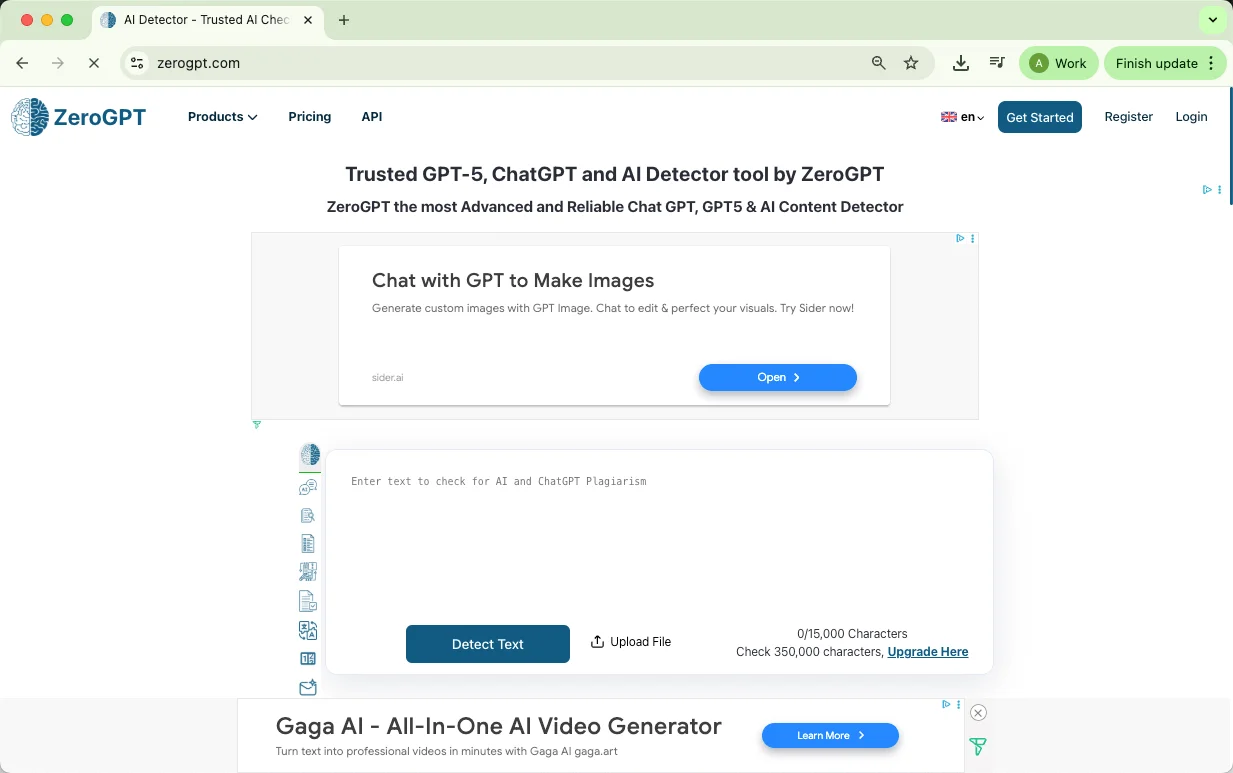
What is ZeroGPT?
ZeroGPT is a comprehensive AI tools platform that includes an AI content detector for identifying text generated by models like ChatGPT, GPT-5, and Gemini. It’s a quick way to check if writing is human-created, AI-generated, or a mix of both. The tool highlights AI-written sentences, provides a percentage gauge of AI involvement, and supports batch uploads with automatically generated PDF reports for record-keeping.
Users simply paste or upload text and click “Detect Text,” after which ZeroGPT’s algorithms analyze patterns and classify content. Results are displayed with a percentage gauge and categories such as:
Human written
AI/GPT generated
Most of your text is AI/GPT generated
Likely generated by AI/GPT
Mixed signals (some AI, some human)
Most likely human with minor AI-generated parts
Extra Tools
Beyond AI detection, ZeroGPT includes:
Plagiarism Checker
AI Grammar Checker
AI Summarization Tool
AI Paraphrasing Tool
AI Translator
Word Counter
Citation Generator
Advanced AI ChatBots (ZeroCHAT4 & ZeroCHAT5)
AI Email Helper
How Accurate is ZeroGPT
ZeroGPT claims high detection accuracy based on its official statements and feature set. According to the developers, after analyzing over 10 million texts—both AI-generated and human-written—the tool achieves up to 98% accuracy using its DeepAnalyse™ Technology. Features like sentence-level highlighting, percentage gauges, batch file uploads, and multilingual support all contribute to its detection capabilities. To verify these claims, we tested different types of texts through ZeroGPT and recorded the results.
Test 1: Pure AI Text
Setup: We generated a fully AI-written passage using GPT-5, ensuring no human editing.
Results: ZeroGPT identified the text as 100% AI-generated, with every AI-written sentence highlighted and the percentage gauge showing maximum AI involvement.
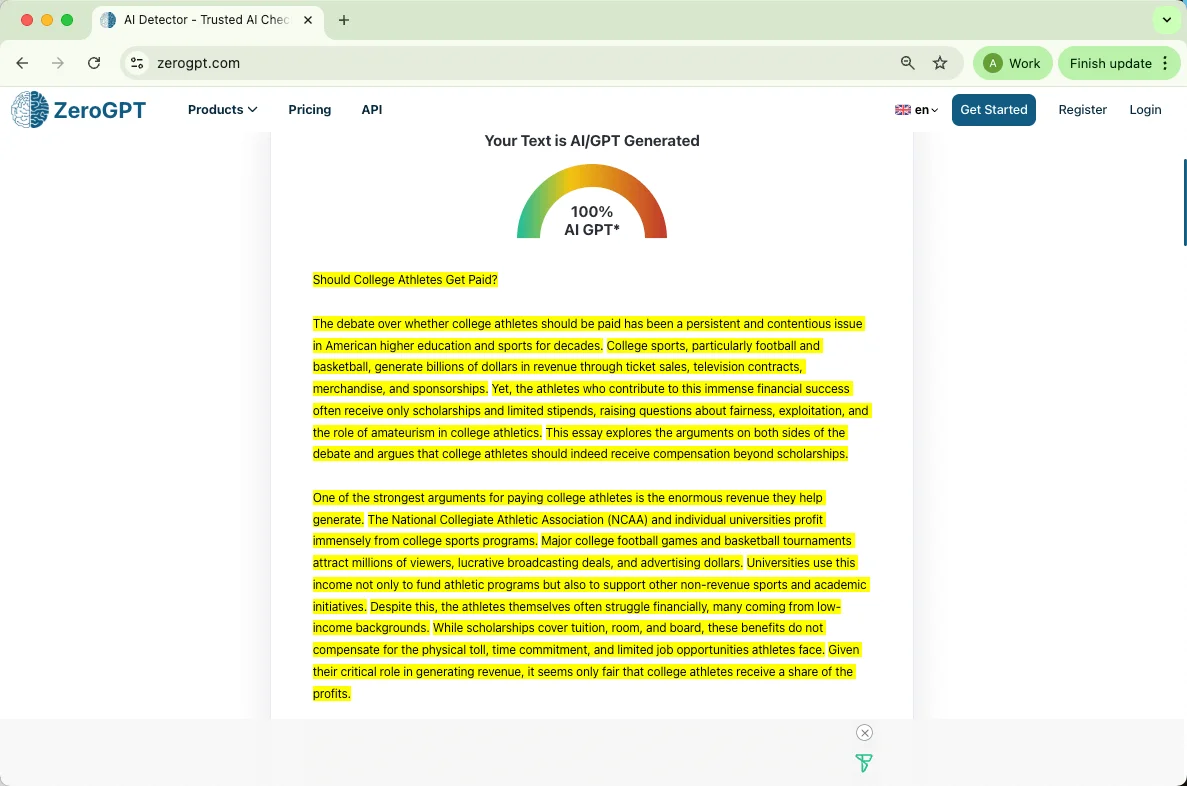
Observations: The tool flagged all sentences correctly, confirming its reliability for fully AI-generated content.
Test 2: Mixed AI + Human Writing (Pre-ChatGPT Era)
Setup: We started with a human-written essay passage from before ChatGPT existed and had GPT-5 continue it. The final text consisted of 454 words, of which 187 were human-written (41%).
Results: ZeroGPT classified it as “Likely generated by AI/GPT” with 60.17% AI involvement.
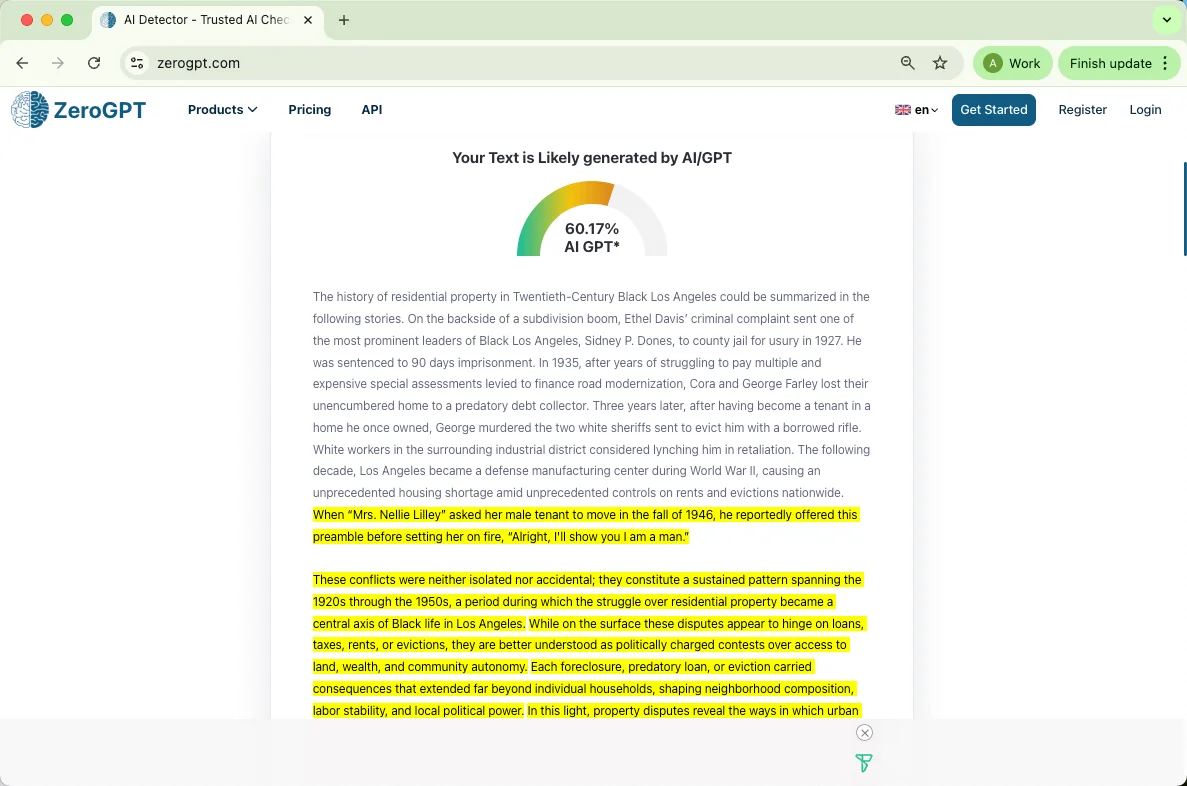
Observations: The detector accurately identified AI-generated portions while accounting for human input, demonstrating its sensitivity to mixed-content texts.
Test 3: Humanized AI Text (via QuillBot)
Setup: We took AI-generated text and refined it using QuillBot’s humanizer mode.
Results: ZeroGPT flagged it as “Most of Your Text is AI/GPT Generated” with 80.65% AI involvement.
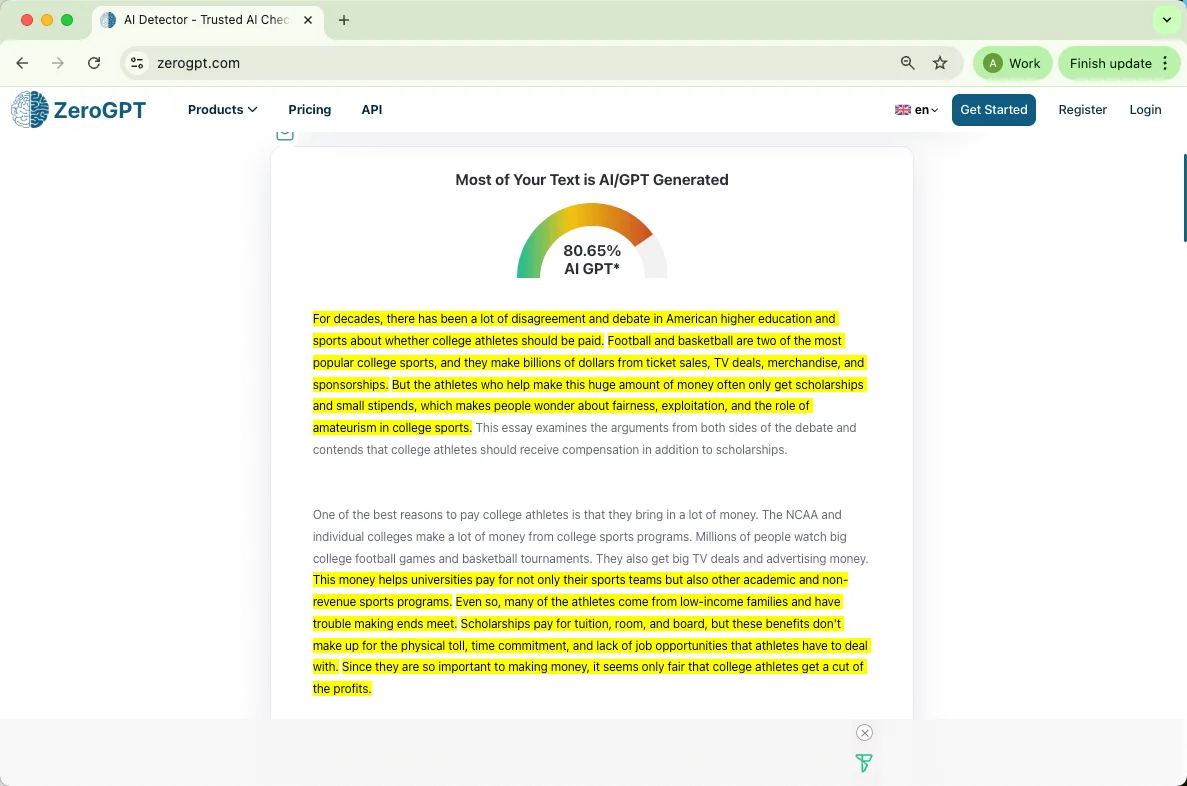
Observations: QuillBot’s advanced rewriting mainly changes wording and phrases, so the text still resembles the original. Even after humanization, ZeroGPT detected a substantial AI footprint, showing it can recognize structural and linguistic patterns typical of AI writing, not just individual word choices.
ZeroGPT AI Detector: Pros and Cons
ZeroGPT has carved out a niche as a reliable AI detection tool, balancing accuracy, ease of use, and extra functionality. While it performs well in identifying AI-generated text, like any tool, it comes with limitations worth noting.
Pros
High Accuracy: ZeroGPT’s DeepAnalyse™ Technology provides detailed AI detection, capable of recognizing structural and linguistic patterns beyond simple word choices.
Lower Cost: More affordable compared to some other AI detection tools on a per-word basis.
Extra Tools: Includes helpful utilities like an AI writing assistant, translator, plagiarism checker, and more.
Free Version Available: You can try the tool without paying, with reasonable limits per use.
Easy to Use: Simple interface and workflow make it accessible even for non-technical users.
Cons
Limited Reporting in Free Version: You can’t generate shareable reports for team collaboration unless you upgrade.
No Sentence-Level Breakdown: Results provide a general percentage rather than highlighting each AI-generated sentence.
Ads in Free Version: Pop-ups can interrupt the workflow.
Potential False Positives: Mixed-content or heavily humanized AI text can sometimes be flagged inaccurately.
ZeroGPT Pricing
ZeroGPT offers both free and paid options, making it flexible depending on your needs.
Free Version
Trial Access: Yes, you can use the free version, but it comes with limitations.
Features: Basic AI detection, limited batch file processing, limited AI tool usage.
Ads: Free version includes ads.
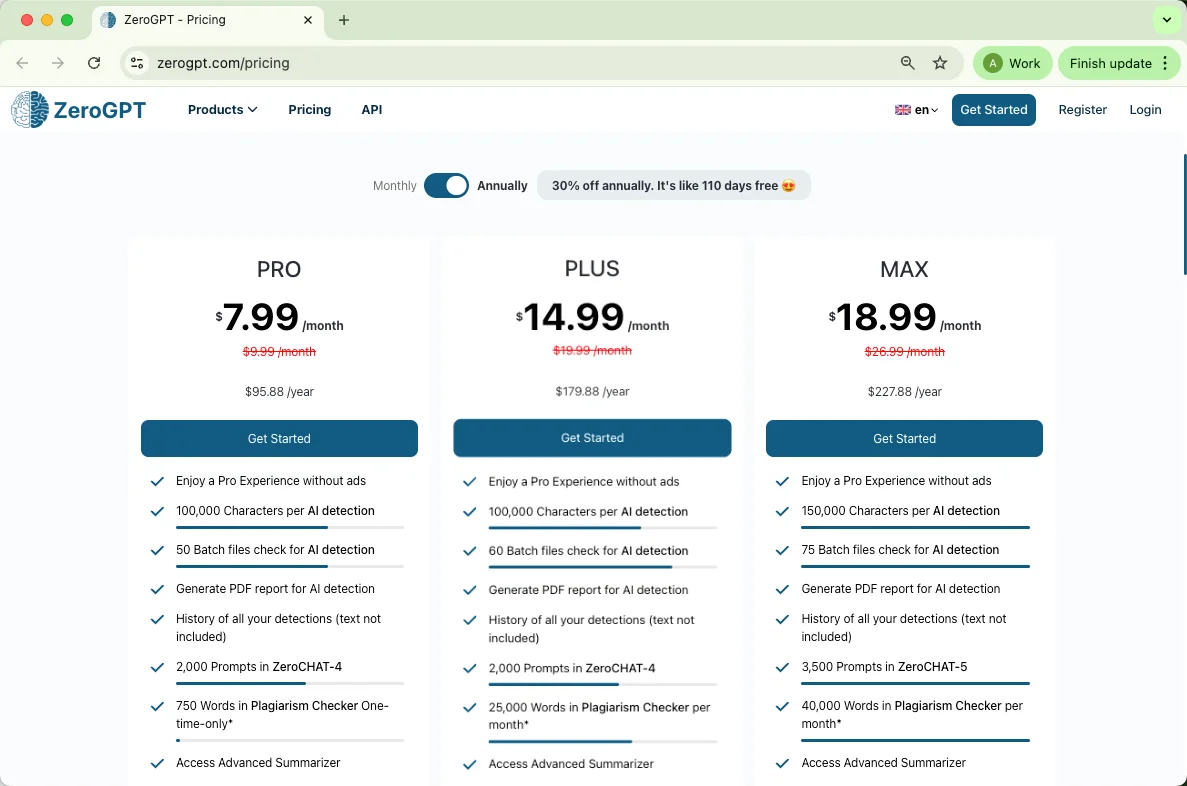
Paid Plans
ZeroGPT has three main paid tiers: Pro, Plus, and Max. Prices start at $9/month, with annual subscriptions offering better value. The main differences between these plans include:
Ad-Free Experience: Paid plans remove ads.
Batch File Processing: Higher-tier plans allow larger batch uploads for AI detection.
AI Detection Capacity: More characters per detection in higher plans.
ZeroCHAT-4 Prompts: Increased number of prompts you can use in the AI chatbot.
Advanced Tools Limits: Higher word limits for AI Summarizer, AI Paraphraser, and other advanced features.
Grammar & Spell Check: Paid plans allow more words per check.
Messaging Integration: Access ZeroGPT on WhatsApp and Telegram for seamless detection on the go.
Overall, the paid plans are designed for users who need frequent, large-scale AI detection or want to use advanced tools and integrations without restrictions.
Can You Bypass ZeroGPT AI Detector?
It’s a question that comes up often: can AI-generated text slip past detectors like ZeroGPT? The answer is nuanced. While ZeroGPT is highly accurate and flags AI-generated content reliably, there are scenarios where writers or students might want to ensure AI-assisted text reads naturally without raising false alarms.
Simple tricks, like swapping words with synonyms or lightly rephrasing sentences, usually won’t work. ZeroGPT doesn’t just scan vocabulary—it analyzes sentence structure, rhythm, and stylistic patterns. That’s why shallow edits are still detectable, as Test 3 above shows: even after a simple rewrite, the AI text still registered 80% AI.
This is where EssayDone Humanizer comes in. EssayDone is a humanization tool built to make AI-generated text appear genuinely human. Instead of merely changing words, it restructures sentences, varies rhythm, and adds stylistic nuances that mimic natural writing.
Why does this work? AI detectors rely on metrics like perplexity (how predictable the text is) and burstiness (variation in sentence length and style). Humans naturally mix short and long sentences, use idioms, and vary tone. Tools like EssayDone introduce these linguistic and structural changes, reducing the patterns that detectors like ZeroGPT flag as AI-generated.
In our tests, we used EssayDone to rewrite Test 1—the fully AI-generated text.
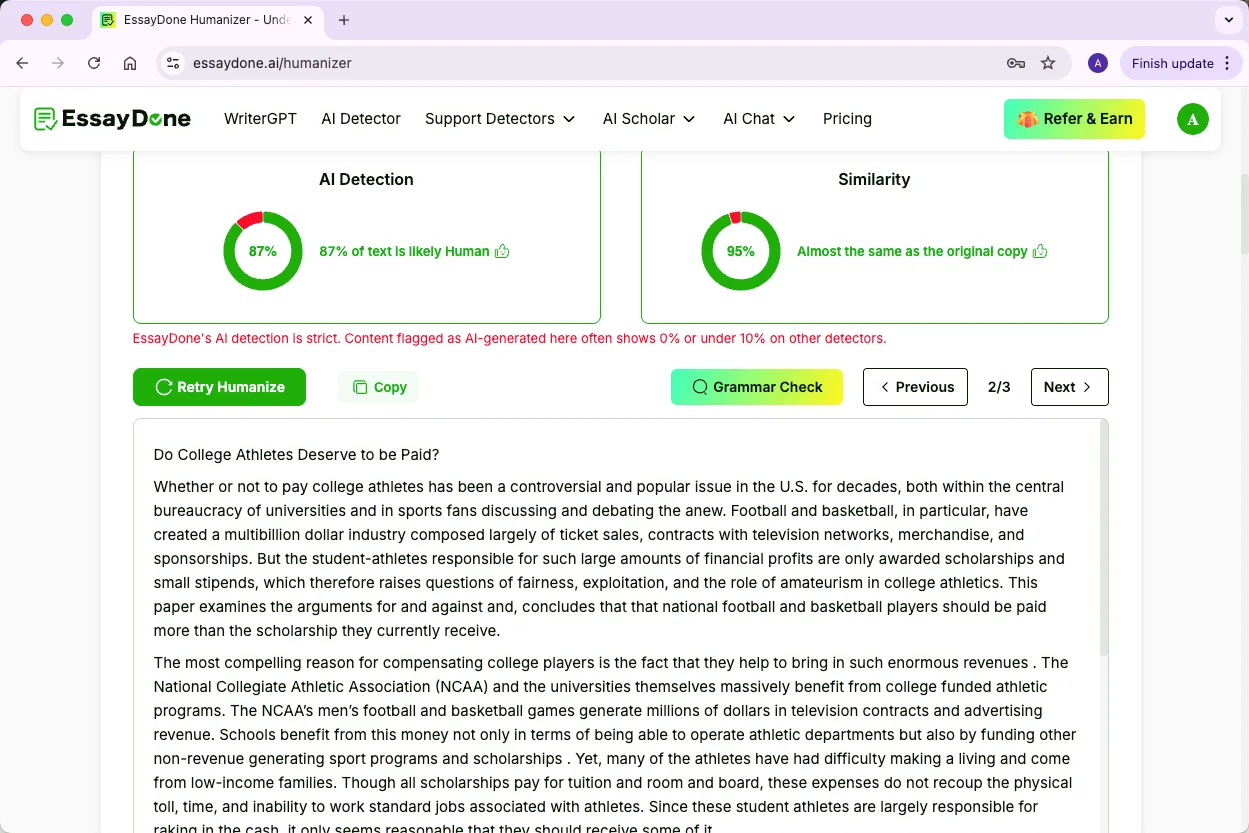
After humanization, the AI detection score dropped from 100% AI to 0% AI, showing the tool’s effectiveness. AI text processed through EssayDone demonstrated a dramatic reduction in AI probability, proving that professional humanization can make AI-assisted writing pass detection while keeping the meaning intact.
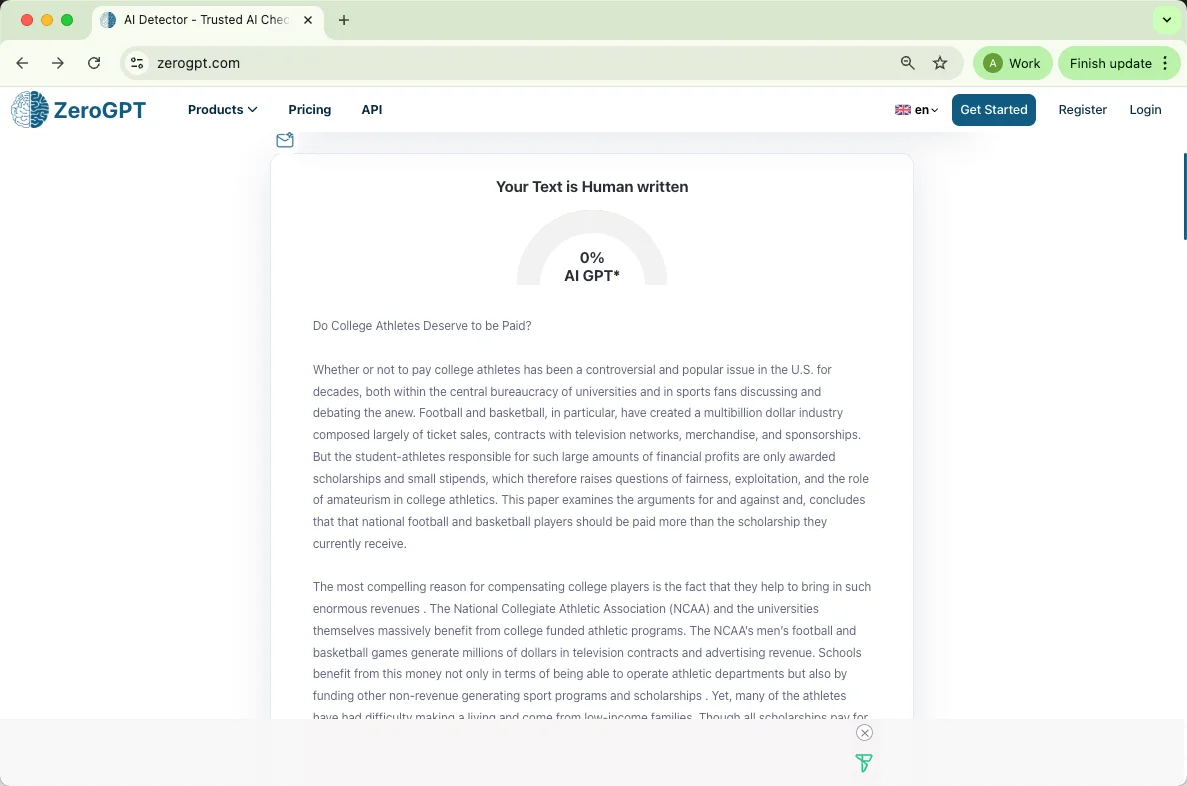
Alternatives to ZeroGPT
Originality.ai: A strict and professional AI detector designed for serious content verification. It works at the sentence level, offering precise AI detection.
GPTZero: Known for its fast, sentence-level analysis and easy-to-understand results. It supports multiple languages but offers only a limited free trial.
Copyleaks: A versatile AI and plagiarism detector with batch processing capabilities. Free to use with signup, but it doesn’t provide sentence-level insights.
Winston AI: A multi-language AI content detector trusted for checking outputs from ChatGPT, GPT-5, and other LLMs. Free with limited quota, supporting languages like English, French, Spanish, Portuguese, German, Dutch, Polish, Italian, Indonesian, and Simplified Chinese.
Writer: Free, user-friendly AI detection tool that works at the sentence level. While easy to use, it may sometimes struggle with accuracy on nuanced AI-generated content.
Scribbr: Primarily a plagiarism detection tool with added AI content detection features. Known for academic-focused accuracy but comes at a higher cost compared to other options.
QuillBot: Popular for paraphrasing and AI detection combined. It highlights AI-generated sentences and provides probability scores, but accuracy may vary depending on text complexity.
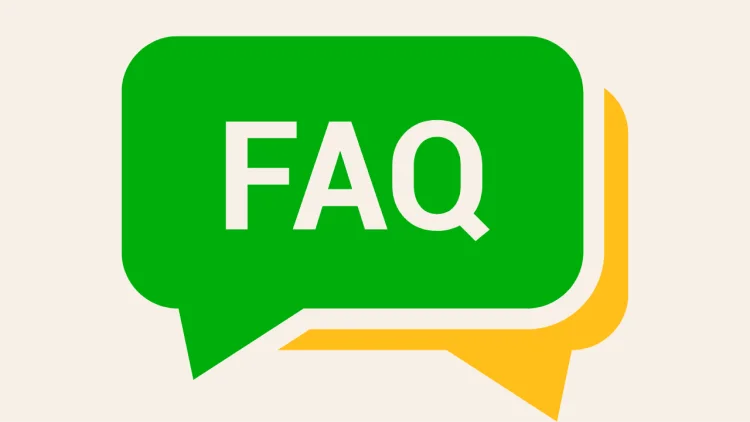
FAQ
Is ZeroGPT 100% accurate?
No AI detector is perfect, including ZeroGPT. While it claims up to 98% accuracy using DeepAnalyse™ Technology, mixed-content texts or heavily humanized AI writing may still produce false positives or slightly off results.
How to bypass ZeroGPT AI detector
Simple word swaps or light paraphrasing usually won’t work because ZeroGPT analyzes sentence structure, rhythm, and stylistic patterns. Tools like Essaydone that introduce professional humanization—structural and linguistic changes—can significantly reduce AI detection probability while keeping the meaning intact.
Will my professor use an AI detector?
Many educators are starting to use AI detectors, especially for essays and assignments submitted online. However, usage varies by institution, so it’s best to assume your work could be checked.
Can I use AI detectors on my own work before submission?
Yes! Running your work through an AI detector like ZeroGPT before submission can help you identify parts that might appear AI-generated, giving you a chance to revise and humanize your content.
Are AI detectors legal?
Yes, using AI detectors is legal. They are tools designed to help educators, writers, and publishers verify content originality or AI involvement without violating any laws.
Conclusion
In this review, we tested ZeroGPT on different types of text—from fully AI-generated to mixed human-AI content—and looked at its features, accuracy, and limitations. The results show it can detect AI patterns effectively, though some mixed or humanized texts may still trigger partial AI detection. We hope this article helps you understand how AI detectors work and what to expect when using them, giving you a clear, practical perspective for your own writing or research.
